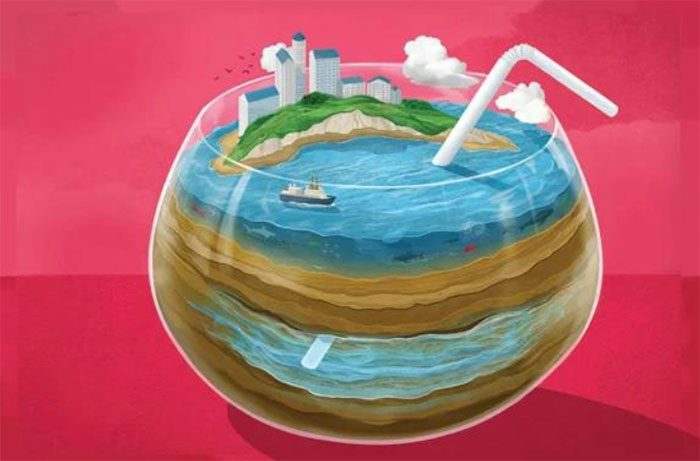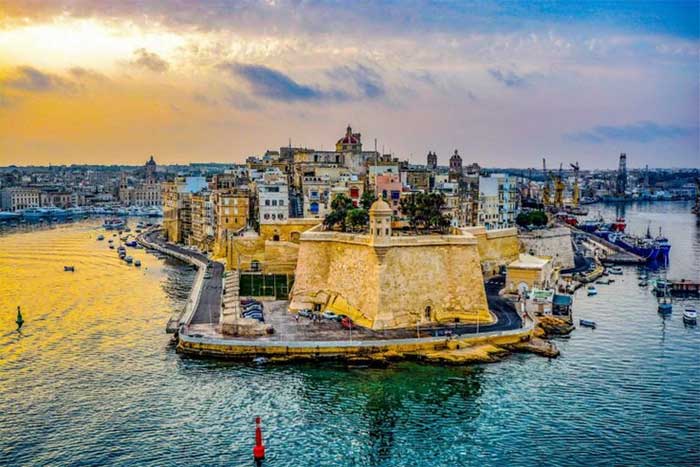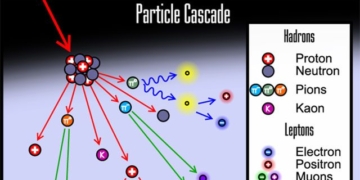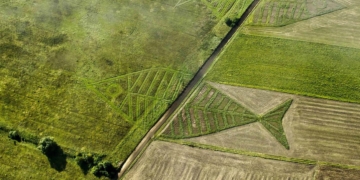Researchers have discovered an increasing number of freshwater reservoirs beneath the seabed offshore continental shelves, raising hopes that one day these sources could help drought-stricken regions.
It All Started with a Coincidence
Back in 1960, the United States Geological Survey drilled a series of vertical wells off the coast of New Jersey in search of sand deposits and other resources. Unexpectedly, they struck a freshwater aquifer. The story ended there.

An illustration depicting a freshwater reservoir beneath the sea – (Photo: SAM FALCONER).
In 2015, aboard the R/V Langseth, Dr. Rob L. led an expedition from Massachusetts to rediscover the freshwater reservoir hidden 100 meters beneath this rocky seabed and create detailed maps of it.
The survey team spent months processing all the data recorded during their 10-day expedition. In 2019, the explorers published their findings.
Excited media outlets raced to publish headlines: “Mysterious Freshwater Reservoir Found Beneath the Ocean.”
Indeed. But how large is it? Why is there freshwater beneath the ocean? How many coastlines around the world have freshwater hidden beneath? The expedition team still does not have the answers.
On the surface of our planet, there is only about 2.5% of freshwater that can be used by humans. Meanwhile, the global population is projected to reach 10 billion by 2100, increasing pressure on freshwater supplies.
Climate change is also altering rainfall patterns, pollution is harming existing water sources, and agricultural development is depleting groundwater.
The initial discovery by the team from the Woods Hole Oceanographic Institution has spurred further research, including recent surveys off the coasts of San Diego, Hawaii, New Zealand, and Malta. These studies are beginning to provide answers.
Freshwater Buried Under the Sea
According to Dr. Evans, a continent does not stop at the coastline; it extends offshore as an underwater shelf. The continental shelf ends at a steep slope transitioning to the deep ocean floor.
Through surveys, researchers have found a groundwater flow inland along the northeastern coast of the United States. This indicates a significant amount of freshwater hidden within the rocks and sediments beneath this continental slope.
Off the East Coast of the United States, the continental shelf stretches from near the shore to over 300 kilometers into the deep sea. The geological layers forming aquifers on land do not stop at the coast; they often extend out into the continental shelf.
When rain falls on coastal land, it can seep into the aquifer and through highly permeable rock types, moving below the shore and eventually reaching the seabed.
To keep this long-flowing stream fresh, a cover over the marine aquifer is necessary—a waterproof layer, typically dense clay-rich sediment.
Clay has a paradox: it can hold a lot of water when loose, but when compacted, it becomes almost impermeable. This cap prevents the lighter freshwater from escaping to the seabed.
Based on the modeled aquifer surveys on land, the research team suggests that there may be freshwater beneath the entire New England continental shelf.

Freshwater lakes beneath the seabed around Malta – (Photo TRAVEL ADVO).
Off the coast of Martha’s Vineyard in Massachusetts, there is also believed to be freshwater beneath the seabed, left by glaciers over 12,000 years ago. A large research team is currently planning to drill in this area in 2024.
Meanwhile, the freshwater off New Jersey seems to partly originate from rainfall on land.
A 2018 survey off Hawaii found clear evidence of freshwater-bearing rock lying hundreds of meters beneath the seabed. Unlike New Jersey, Hawaii is formed from volcanic rock, which has relatively high permeability.
Further south along the South China Sea, the coastal geology shifts predominantly to limestone; the movement of groundwater there may behave differently.
From September 2019 to September 2020, researchers using CSEM sensors demonstrated that brackish groundwater in the San Diego formation—a major groundwater source for the city—was connected to a freshwater aquifer offshore Coronado Island.
Mapping freshwater in 2022 in the Mediterranean, researchers discovered a freshwater lake beneath the seabed off the island of Malta. This lake may be supplied by groundwater from the shore.
Community efforts are increasing, especially in Europe, to explore the potential for freshwater reservoirs beneath the seabed. More surveys will gradually uncover the mysteries and reveal even more surprises.





















































